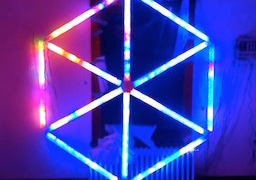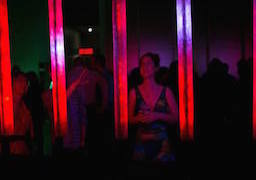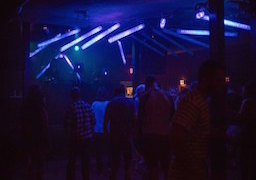Illumination Tubes
Overview
Pentagraphic Illumination is comprised of a set of translucent tubes containing programmable LED strips. The tubes are connected to form a “closed-loop scissor mechanism” (CLSM). An example of a CLSM is illustrated in Fig. 1 which shows a six-sided CLSM at three levels of extension. The structure is supported at the bottom by six pistons connected to a cylinder which allows the entire structure to be actuated from its centre.
Fig. 2 shows a rendering of a more realistic CAD model for the project. This structure has been reduced to a four-sided CLSM, and considers only a single level. Insets a) and b) show the rotational joint used to form the centre of each scissor section and the universal joint to connect their corners.
Each tube contains an aluminum rod at its core, with a transparent PVC tube surrounding it. Programmable LED strips are attached to the aluminum rod. Rowlux illusion film is placed inside the PVC tube for light diffusion.
The mechanical structure would be controlled manually by participants. Sensors would detect the changing shape and alter the light pattern based on algorithms written using openFrameworks, a C++ open source toolkit. Sound reactivity, Xbox kinect 3D motion sensing, and push-button controls would provide further interactivity.
The installation can easily be scaled by adjusting the size of the CLSM. A three level, six-sided CLSM would be amazing; but a single-level, four-sided CLSM would still be cool.
Interactive
Pentagraphic Illumination is inherently interactive, so it provides ample opportunity for participation. We like to incorporate cutting edge digital technologies in our work. Not only does this provide novel means of expression (e.g. gesture recognition), but it also just looks super rad. And let’s be honest… the glowing lights on the playa are big part of Burning Man. We would love to contribute to it, and hope that our sound-reactive light would attract the best art cars.
The kinetic aspect of the installation adds a touch of old-school charm. Our preference would be a fully manual control mechanism, rather than using motors to change the shape. This would really encourage people to engage with the installation and feel a connection to it. Moreover, we would likely create a somewhat-elaborate system of gears, pulleys, cranks, etc… the sort of thing you might expect to see in Da Vinci’s workshop :). Not only do the mechanics of this installation connect with the theme, it also encourages people to appreciate each moment of its ever-changing nature.
Of course, we would want to ensure that all persons had an opportunity to interact with the installation. While exhibiting our “SoundCastle” installation (shown on our website), we had a participant who struggled to interact with it because she was in a wheelchair. This was an important lesson for us, and we took to heart her suggestion that we endeavor to ensure that our work is as inclusive as possible.










